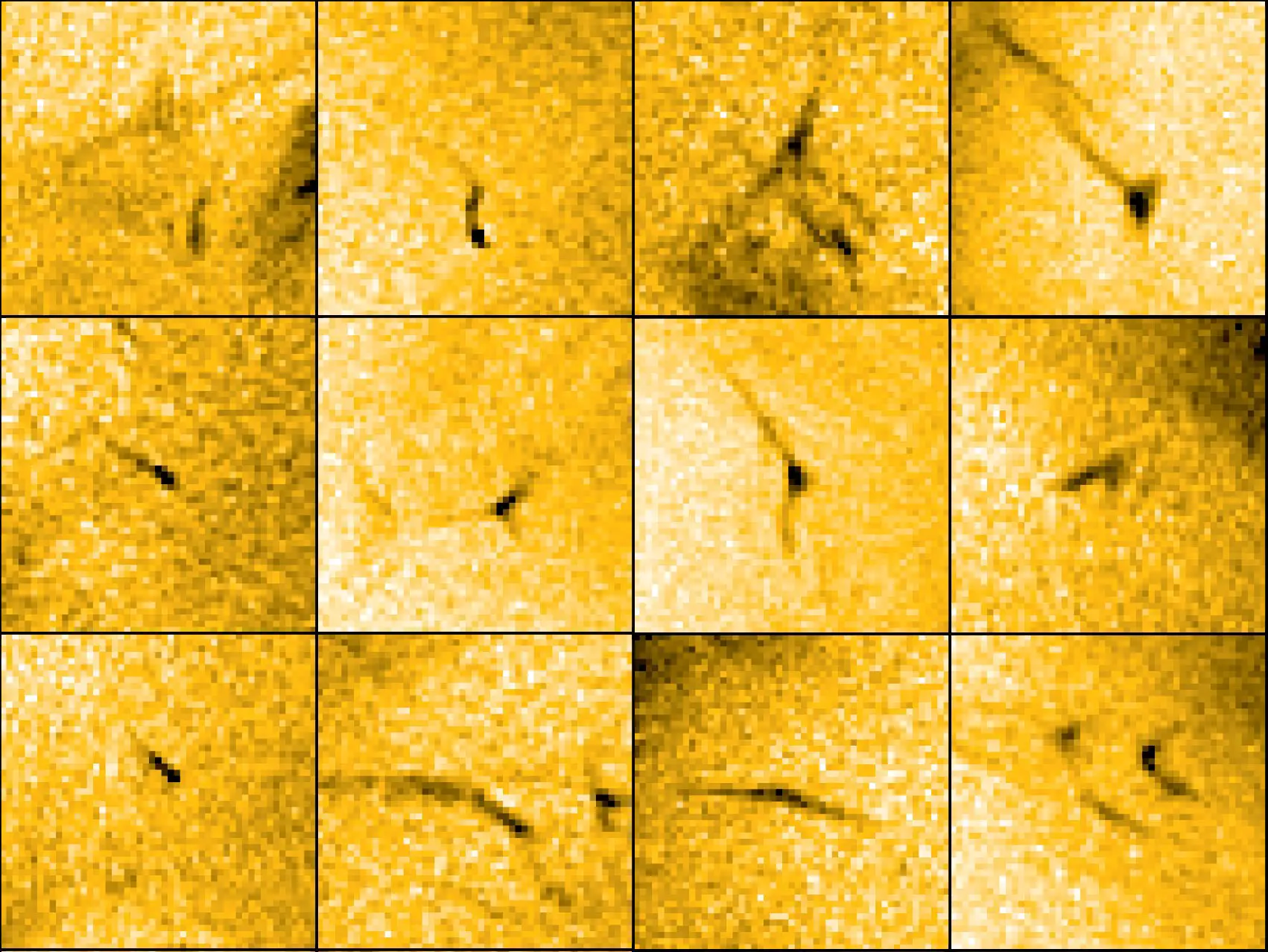

This mosaic of images shows a multitude of tiny jets of material escaping from the Sun’s outer atmosphere. The images come from the ESA/NASA Solar Orbiter spacecraft. They show up as dark streaks across the solar surface in this mosaic. The images are ‘negatives’ meaning that although the jets are displayed as dark, they are bright flashes against the solar surface. Credit: ESA & NASA/Solar Orbiter/EUI Team; acknowledgment: Lakshmi Pradeep Chitta, Max Planck Institute for Solar System Research, CC BY-SA 3.0 IGO
Images from the Solar Orbiter revealed small “picoflare” jets within a coronal hole on the Sun, which might supply energy to the solar wind, enhancing our understanding of space weather origins.
Extreme ultraviolet images of the Sun captured by the Solar Orbiter spacecraft have unveiled many small-scale jets present within a coronal hole. The researchers behind the study have termed these jets as “picoflare” jets. They propose that these picoflare jets might supply energy and plasma to the solar wind. This wind, a continuous stream of charged particles emanating from the Sun’s corona, is a significant element of space weather inside the heliosphere.
Connection to Coronal Holes
Solar wind streams have origins traceable to coronal holes, which are areas on the Sun’s outer atmosphere. While it’s speculated that these coronal holes might be the primary sources of solar wind, the exact mechanism of how the wind emerges from them is still a mystery. To delve deeper into this phenomenon, Lakshmi Chitta and his team observed a coronal hole using the Extreme Ultraviolet Imager (EUI) instrument aboard the Solar Orbiter spacecraft. They identified various small-scale plasma jets present within this coronal hole.
This movie was created from observations taken by the ESA/NASA Solar Orbiter spacecraft on March 30, 2022, between 04:30 and 04:55 UTC, and was previously released last year. It shows a ‘coronal hole’ near the Sun’s south pole. Subsequent analysis revealed many tiny jets being released during the observation. They show up as little flashes of bright light across the image. Each one expels charged particles, known as plasma, into space. The circle indicates the size of the Earth for scale. Credit: ESA & NASA/Solar Orbiter/EUI Team; acknowledgment: Lakshmi Pradeep Chitta, Max Planck Institute for Solar System Research
Characteristics of Picoflare Jets
These widespread yet faint jets, only a few hundred kilometers across, were seen to last between 20 to 100 seconds, achieving speeds of approximately 100 kilometers per second. Their energy appears to be derived from magnetic reconnection. Due to their relatively low kinetic energies, Chitta and his colleagues named these structures picoflare jets. Based on their calculations, they suggest that plasma outflows from these numerous, frequent picoflare jets, channeled along the open magnetic field lines of coronal holes, might supply a considerable amount of mass and energy to the solar wind throughout the solar cycle.
Expert Perspectives
In a related Perspective, Ignacio Ugarte-Urra and Yi-Ming Wang discuss the study and its findings in greater detail.
For more on this discovery, see Solar Orbiter Discovers Tiny Jets That Could Power the Solar Wind.
References:
“Picoflare jets power the solar wind emerging from a coronal hole on the Sun” by L. P. Chitta, A. N. Zhukov, D. Berghmans, H. Peter, S. Parenti, S. Mandal, R. Aznar Cuadrado, U. Schühle, L. Teriaca, F. Auchère, K. Barczynski, É. Buchlin, L. Harra, E. Kraaikamp, D. M. Long, L. Rodriguez, C. Schwanitz, P. J. Smith, C. Verbeeck and D. B. Seaton, 24 August 2023, Science.
DOI: 10.1126/science.ade5801
“Thin jets underlie the solar wind: Solar Orbiter images reveal widespread magnetic plasma jets at the roots of the solar wind” by Ignacio Ugarte-Urra and Yi-Ming Wang, 24 August 2023, Science.
DOI: 10.1126/science.adj8002